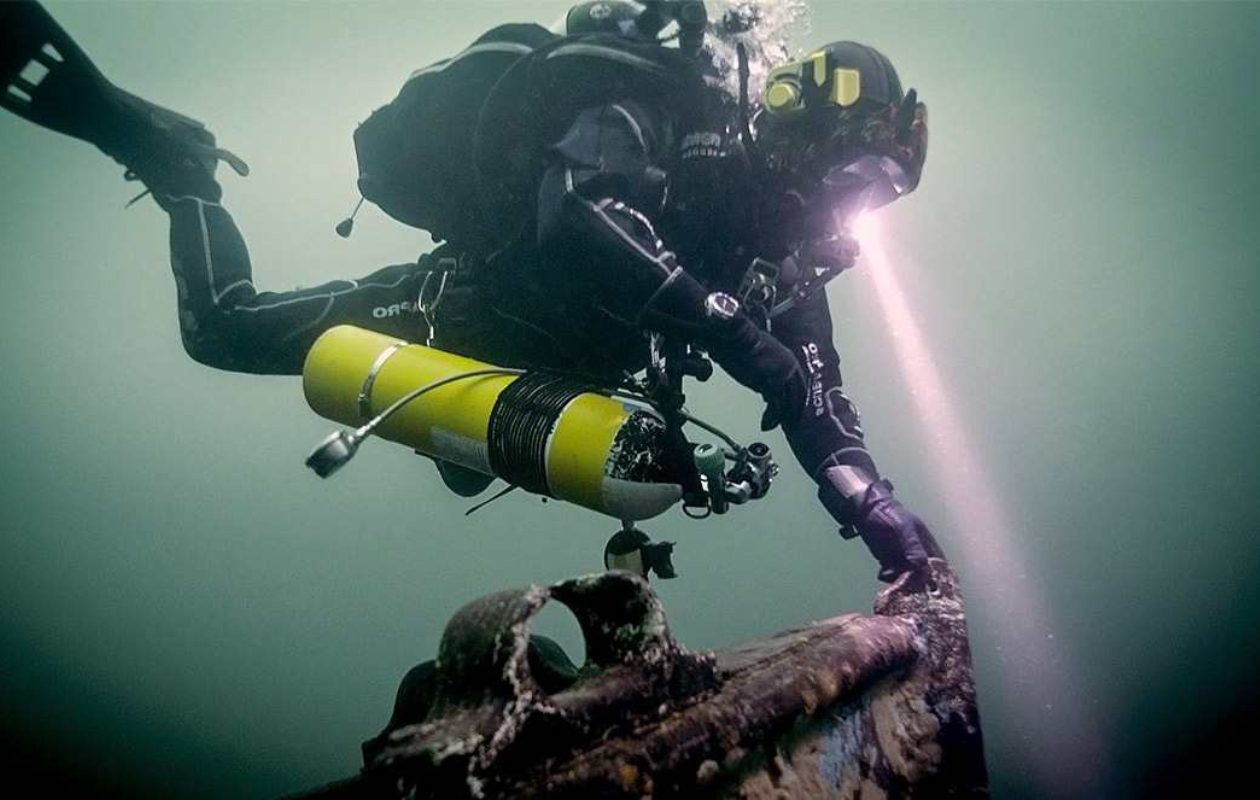Diving flashlights, also known as dive lights or underwater torches, are specialized flashlights designed for use underwater. They are essential tools for divers and snorkelers, as they provide illumination in the often dark and murky underwater environment.
But how to choose the best flashlight for diving, which at the same time will not ruin our pocket? This is what we will talk about today. Let’s move on to the topic of all things underwater torches.
Table of Contents
Why do I need diving flashlights?
Diving flashlights are essential scuba tools for several reasons. Let’s start with visibility. Underwater environments can be dark, especially at greater depths or in areas with limited natural light. Diving flashlights provide a powerful beam of light that illuminates the surroundings, allowing you to see clearly and navigate effectively. They help you spot marine life, coral reefs, and other underwater features, enhancing your overall diving experience.
What about underwater photography? If you’re interested in capturing the underwater world through photography or videography, diving flashlights are vital. They provide the necessary lighting to properly illuminate your subjects, enhance colors, and capture clear and detailed images or footage. The same goes for marine life observation. Diving flashlights enable you to appreciate the vibrant and diverse marine life more effectively. They help you spot hidden creatures, examine small details, and reveal the natural beauty of the underwater world.
Flashlights for night and wreck diving
Here I think there is no question that in diving of this type you need a good underwater torch. Flashlights for night and cave diving are essential tools that provide crucial illumination in dark and challenging underwater environments. These specialized flashlights are designed to meet the unique requirements of divers exploring the depths or navigating through intricate cave systems.


Flashlights specifically designed for night diving and cave diving provide divers with the necessary illumination and features to safely explore these challenging environments. It is important for divers to choose reliable, high-quality flashlights from reputable manufacturers and to be trained and experienced in the techniques and safety protocols associated with night and cave diving.
How to choose a good diving flashlight?
If you want to choose the optimal flashlight for diving, you need to start with its intended use and desired operating time. Requirements can vary depending on factors such as diving depth, water temperature and visibility conditions. For divers undertaking deep dives in cold waters with varying clarity, certain parameters become important. Conversely, divers engaged in extensive cave exploration prioritize different aspects. In technical diving scenarios, important features include larger flashlights equipped with a large head and battery, providing both intense illumination and extended runtime. Such flashlights are often designed to be compatible with dive heaters, further enhancing their functionality.
So the first question you need to ask yourself is what you want this flashlight to be used for. In the second place you will focus on the technical differences, and in the last place you will look at the price. This is the only way that makes the most sense. Otherwise, you’ll end up with a tiny flashlight on a serious exploration trip, or, on the other hand, a big carboy with batteries on a recreational weekend dive. I hope you understand – it is impossible to have equipment “for everything”.
Choosing the best diving flashlights.
As you can see, as with any other diving equipment, be it a mask or a BCD, it is the same with a flashlight. It must be properly selected for its intended use. Otherwise, it will look ridiculous, to say the least. Now that you’ve answered the question of why you need a diving flashlight, we can move on to the next step, which is the technical differences. What aspects are worth paying attention to? Let’s see.
Flashlight power that is, Lumens
Lumens are a unit of measurement used to quantify the total amount of visible light emitted by a light source. In simpler terms, lumens measure the brightness or intensity of light. The higher the number of lumens, the brighter the light output. When it comes to flashlights, lumens are commonly used to indicate the maximum light output or brightness level of the flashlight. For example, a flashlight with a higher lumen rating will produce a brighter light beam compared to a flashlight with a lower lumen rating.
It’s important to note that while lumens provide a general indication of brightness, they do not tell the whole story. The beam distance, beam angle, and quality of the light also play a significant role in how effectively the light is projected and how well it illuminates a particular area. Additionally, factors such as battery life, beam pattern, and color rendering should be considered when evaluating the overall performance of a flashlight.
The angle of illumination
The angle of illumination of a flashlight refers to the width of the beam of light it produces. It determines how broad or narrow the area of illumination will be. The angle of illumination is usually measured in degrees and can vary depending on the design and purpose of the flashlight. A wide angle of illumination, often referred to as a flood beam or wide beam, provides a broader coverage area. It spreads the light over a larger space, making it suitable for tasks that require general area lighting or for situations where a wide field of vision is needed.
On the other hand, a narrow angle of illumination, known as a spot beam or focused beam, concentrates the light into a narrower beam. This type of beam is more intense and reaches farther distances, making it suitable for illuminating specific objects or distant points. Some flashlights offer adjustable beam angles, allowing users to switch between flood and spot beams depending on their needs. This versatility can be useful in various situations, allowing for customization of the illumination based on the task at hand.
The angle of illumination is an important factor to consider when selecting a flashlight. It determines the coverage area and the reach of the light, so it’s essential to choose a flashlight with the appropriate beam angle for your specific needs and preferences.


Color temperature or light color
Color temperature refers to the appearance of light produced by a light source and is measured in Kelvin (K). It describes the color characteristics of the light emitted, ranging from warm to cool tones. In the context of flashlights or lighting in general, color temperature is used to indicate the perceived “warmth” or “coolness” of the light. Lower color temperatures, typically ranging from 2000K to 4000K, produce a warm or yellowish light resembling the color of a candle flame or incandescent bulb. This warm light is often considered cozy and relaxing.
On the other hand, higher color temperatures, typically ranging from 5000K to 6500K or higher, produce a cool or bluish light similar to daylight or overcast sky. This cool light is often associated with clarity and alertness. The choice of color temperature depends on personal preference and the intended use of the flashlight. For example, a warmer color temperature might be preferred for a flashlight used in a camping setting to create a cozy atmosphere, while a cooler color temperature might be preferred for a flashlight used for outdoor activities or working in low-light conditions where increased visibility and clarity are important.
It’s worth noting that color temperature is different from the color rendering index (CRI), which measures how accurately a light source renders colors compared to natural light. While color temperature determines the overall color appearance, the CRI provides information about the quality and accuracy of the light source’s color rendering capabilities. When choosing a flashlight, considering the color temperature can help create the desired ambiance or provide appropriate lighting for the intended purpose.
Flashlight runtime on battery
Flashlight runtime refers to the duration of time that a flashlight can continuously operate on a single set of batteries before the light output diminishes to a specified level. It is an important factor to consider when selecting a flashlight, especially for situations where extended or prolonged use is required.
The runtime of a flashlight can vary depending on factors such as the type and quality of batteries used, the brightness level selected, and the efficiency of the flashlight’s circuitry. Higher brightness levels generally result in shorter runtimes, as they require more power to produce brighter light. Manufacturers often provide estimated runtime specifications based on certain conditions, such as using fresh batteries and operating the flashlight at a specific brightness level. It’s important to note that these estimates may vary in real-world usage, as factors like battery age, temperature, and the presence of battery-saving features can influence the actual runtime.
Rechargeable flashlights typically provide longer overall runtime compared to those using disposable batteries, as they can be recharged and used multiple times. Additionally, some flashlights offer adjustable brightness levels or multiple modes, allowing users to select a lower brightness setting to extend the runtime when maximum brightness is not required.
To ensure optimal runtime, it is recommended to use high-quality batteries and keep spare batteries on hand for extended use or emergencies. It’s also essential to follow proper battery handling and storage practices to maintain battery performance and maximize runtime. When selecting a flashlight, considering the expected duration of use and the required runtime is important to ensure that the flashlight meets your specific needs and can provide sufficient illumination for the intended duration.
Power supply
One more thing you need to think about when choosing underwater flashlights is the type of power supply. Flashlights can be powered by different sources and, again, it all depends on its purpose. The most popular options for powering flashlights include:
Disposable Batteries: Flashlights often use standard disposable batteries, such as alkaline batteries (AA, AAA, C, D) or lithium batteries. These batteries are easily replaceable when depleted, but they may have a limited runtime and require regular replacement. In addition, in more remote areas it may be a problem to get good batteries or they may be of low quality.
Rechargeable Batteries: Many flashlights now come with built-in rechargeable battery packs or support removable rechargeable batteries. Rechargeable flashlights can be charged using a power source, such as a USB cable, wall adapter, or dedicated charger. They offer the advantage of longer-term cost savings and reduced waste compared to disposable batteries.
Built-in Li-ion Batteries: Some flashlights feature built-in lithium-ion (Li-ion) batteries that are rechargeable via a USB port. These flashlights often provide convenient charging options and eliminate the need for separate batteries. Most of the more serious underwater flashlights are equipped with an internal battery pack, which is charged with a special charger.


Accessories for diving flashlights
There are several accessories available for diving flashlights that can enhance their functionality and improve the overall diving experience. Some common accessories for diving flashlights include:
Wrist or Hand Mounts. These straps or mounts allow divers to secure the flashlight to their wrist or hand, keeping it easily accessible while keeping their hands free for other tasks.
Goodman Handles. Goodman handles are specialized handles designed to be worn on the back of the hand, providing a secure grip on the flashlight. They are often used in cave diving or technical diving, where precise control and maneuverability of the light source are crucial.
Pistol Grips. Pistol grips are ergonomic handles that attach to the flashlight, resembling the grip of a handgun. They provide a comfortable and secure grip, particularly useful for divers who prefer a more traditional flashlight holding style.
Ball and Joint Arms. These adjustable arms allow divers to attach their flashlight to their dive gear or camera rig. They enable precise positioning of the light source, making them useful for underwater photography or videography.
Filters and Diffusers. Filters and diffusers are attachments that can be placed over the flashlight’s lens to modify the light output. Filters can alter the color of the light, enhancing or correcting the lighting conditions underwater. Diffusers help spread the light and create a softer, more even illumination.
Lanyards and Retractors. Lanyards and retractors provide added security by attaching the flashlight to the diver’s equipment. They help prevent accidental loss or dropping of the flashlight, especially in challenging or high-current diving environments.
Spare Batteries and Chargers. Carrying spare batteries and chargers ensures that you have backup power available during longer dives or multi-day diving trips. It’s important to keep the batteries properly charged and replace them as needed to maintain the flashlight’s performance.
Protective Cases. Protective cases or pouches are useful for storing and transporting the flashlight, providing protection against impacts, scratches, and moisture.
Dive Lights Stands or Tripods. These accessories allow divers to set up their flashlights on the seabed or a stable surface, providing hands-free illumination during tasks or for underwater communication.
Other accessories
The specific accessories needed will depend on individual preferences, diving goals, and the type of diving being undertaken. It’s important to ensure that any accessory used with a diving flashlight is compatible, durable and suitable for underwater use. Of course, for technical diving or even using underwater scooters you will use other accessories. But that’s a topic for another discussion.


Diving flashlights let’s recap
When choosing a diving flashlight seek guidance from experienced instructors who have extensively tested various models. Their expertise can provide valuable insights and help narrow down the options. If you know what you need a flashlight for then choose one that will meet the maximum number of requirements. Price is a secondary consideration. Of course, also check the warranty coverage and duration. You wouldn’t want to find out that the small print says the warranty does not cover underwater use….
Don’t buy from untested sources. A used diving flashlight like any other piece of equipment can be a good option. But remember – if you don’t know the seller, you can’t verify how it was used. And most importantly, whether the batteries were properly charged and still guarantee optimal runtime. Inexperienced divers are also unable to determine whether the flashlight was flooded…. Saving money at the start may involve unplanned expenses in the future.






